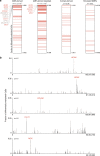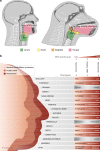Differential DNA methylation of vocal and facial anatomy genes in modern humans
- PMID: 32132541
- PMCID: PMC7055320
- DOI: 10.1038/s41467-020-15020-6
Differential DNA methylation of vocal and facial anatomy genes in modern humans
Abstract
Changes in potential regulatory elements are thought to be key drivers of phenotypic divergence. However, identifying changes to regulatory elements that underlie human-specific traits has proven very challenging. Here, we use 63 reconstructed and experimentally measured DNA methylation maps of ancient and present-day humans, as well as of six chimpanzees, to detect differentially methylated regions that likely emerged in modern humans after the split from Neanderthals and Denisovans. We show that genes associated with face and vocal tract anatomy went through particularly extensive methylation changes. Specifically, we identify widespread hypermethylation in a network of face- and voice-associated genes (SOX9, ACAN, COL2A1, NFIX and XYLT1). We propose that these repression patterns appeared after the split from Neanderthals and Denisovans, and that they might have played a key role in shaping the modern human face and vocal tract.
Conflict of interest statement
The authors declare no competing interests.
Figures






Similar articles
-
Reconstructing Denisovan Anatomy Using DNA Methylation Maps.Cell. 2019 Sep 19;179(1):180-192.e10. doi: 10.1016/j.cell.2019.08.035. Cell. 2019. PMID: 31539495
-
Predicted Archaic 3D Genome Organization Reveals Genes Related to Head and Spinal Cord Separating Modern from Archaic Humans.Cells. 2019 Dec 24;9(1):48. doi: 10.3390/cells9010048. Cells. 2019. PMID: 31878147 Free PMC article.
-
Evolution of genetic networks for human creativity.Mol Psychiatry. 2022 Jan;27(1):354-376. doi: 10.1038/s41380-021-01097-y. Epub 2021 Apr 21. Mol Psychiatry. 2022. PMID: 33879864 Free PMC article. Review.
-
Analysis of differentially methylated regions in great apes and extinct hominids provides support for the evolutionary hypothesis of schizophrenia.Schizophr Res. 2019 Apr;206:209-216. doi: 10.1016/j.schres.2018.11.025. Epub 2018 Dec 11. Schizophr Res. 2019. PMID: 30545758
-
Progress and Prospects in Epigenetic Studies of Ancient DNA.Biochemistry (Mosc). 2021 Dec;86(12):1563-1571. doi: 10.1134/S0006297921120051. Biochemistry (Mosc). 2021. PMID: 34937535 Review.
Cited by
-
The regulation mechanisms and the Lamarckian inheritance property of DNA methylation in animals.Mamm Genome. 2021 Jun;32(3):135-152. doi: 10.1007/s00335-021-09870-8. Epub 2021 Apr 15. Mamm Genome. 2021. PMID: 33860357 Review.
-
Comparative physiological anthropogeny: exploring molecular underpinnings of distinctly human phenotypes.Physiol Rev. 2023 Jul 1;103(3):2171-2229. doi: 10.1152/physrev.00040.2021. Epub 2023 Jan 5. Physiol Rev. 2023. PMID: 36603157 Free PMC article. Review.
-
The Genetic Origin of Daunians and the Pan-Mediterranean Southern Italian Iron Age Context.Mol Biol Evol. 2022 Feb 3;39(2):msac014. doi: 10.1093/molbev/msac014. Mol Biol Evol. 2022. PMID: 35038748 Free PMC article.
-
Pervasive findings of directional selection realize the promise of ancient DNA to elucidate human adaptation.bioRxiv [Preprint]. 2024 Sep 15:2024.09.14.613021. doi: 10.1101/2024.09.14.613021. bioRxiv. 2024. PMID: 39314480 Free PMC article. Preprint.
-
The shared genetic architecture and evolution of human language and musical rhythm.bioRxiv [Preprint]. 2023 Nov 2:2023.11.01.564908. doi: 10.1101/2023.11.01.564908. bioRxiv. 2023. Update in: Nat Hum Behav. 2025 Feb;9(2):376-390. doi: 10.1038/s41562-024-02051-y. PMID: 37961248 Free PMC article. Updated. Preprint.
References
-
- Gokhman, D. et al. Reconstructing the DNA methylation maps of the Neandertal and the Denisovan. Science344, 523–527 (2014). - PubMed
Publication types
MeSH terms
Substances
Grants and funding
LinkOut - more resources
Full Text Sources
Molecular Biology Databases
Research Materials

